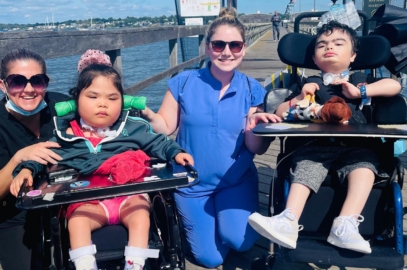March 14, 2019

Art therapy uses art media, the creative process and the resulting art work as therapeutic and healing process with clients”. It is used based on the belief that the creative process involved in artistic self-expressions helps people: explore their feelings, reconcile emotional conflicts, foster self-awareness, manage behavior, develop social skills, improve reality orientation, reduce anxiety and increase self-esteem.
It is practiced in mental health, rehabilitation, medical, educational and forensic settings as well as in private practice, in workshops and small-group settings. It is an effective treatment for persons experiencing developmental, medical, educational, social or psychological impairment. A key goal in art therapy is to improve or restore the client’s functioning and his/her sense of personal well-being.
St. Mary’s Art for Healing Program has been proven to sharpen the minds of St. Mary’s Kids as well as condition their speech. Kids with medical complexities who are exposed to the arts are able to free their imaginations from the constraints imposed by physical limitations. In doing so, these kids achieve increased levels of confidence and self-esteem, as they develop new skills and approached to seeing the world in a whole new way.
How do you become an Art Therapist?
Art therapists are trained in both art and therapy. The process is grounded in the knowledge of human development, psychological theories and counseling techniques. A Master’s Degree is required for entry level practice in Art Therapy. Minimum educational and professional standards are established by the American Art Therapy Association, Inc (AATA), a membership and advocacy organization. Art therapy is growing and the professional, academic and research foundation is expanding. The Art Therapy Credentials (ATCB) continues to invest in art therapy’s professional standards and ethics and is the only nationally credentialing organization for art therapists for art therapists in the United States”.
Art therapy began in hospitals in the 1940’s where it was observed that art making enhanced health and well-being and the recovery process as an adjunct therapy to “talk therapy”. Within the hospital setting art therapists function in child life programs as activity therapists, recreation therapists, and creative art therapists.

“As an Art therapist I enjoy fostering the development of skills and interest in the toddlers especially. When a child for instance states they don’t enjoy art but then months later they are requesting to do art with me is especially rewarding. Additionally, it is important that the child knows they have control in what they do in art while hospitalized. I have seen social skills improve with sharing in the toddler groups and fine motor skills improve from holding a paintbrush appropriately. Also, the child develops an interest in art whereas it may not have existed.” – Daria Swinton, St. Mary’s Art Therapist






